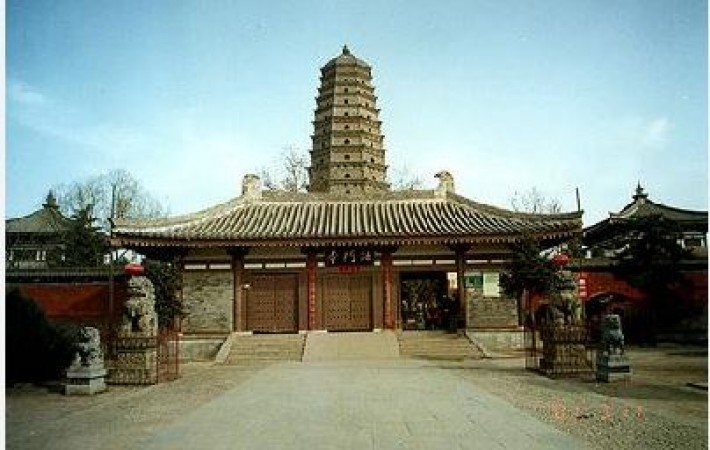
Famen Temple, situated in the Guanzhong Plain of Shaanxi Province, China, holds a significant place in Chinese history and religious culture. With a history spanning over a millennium, Famen Temple has witnessed the rise and fall of dynasties, the flourishing of Buddhism, and the preservation of valuable artifacts and relics. This sacred site continues to attract visitors from around the world, seeking to delve into the rich spiritual and historical heritage it embodies.
Famen Temple's origins can be traced back to the Eastern Han Dynasty (25-220 AD), although it gained significant prominence during the Tang Dynasty (618-907 AD). It was during the Tang Dynasty that the temple's reputation soared as it became associated with miraculous events and invaluable relics.
Also Read: Maya Devi Temple, Lumbini: Discovering the Sacred Birthplace of Lord Buddha
During the Tang Dynasty, Famen Temple attained a status of national importance as one of the most revered Buddhist temples in China. It served as a center of religious and cultural exchange, attracting pilgrims, scholars, and dignitaries from far and wide. Emperor Xuanzong of Tang (r. 712-756 AD) was one of the temple's ardent supporters and played a crucial role in enhancing its grandeur.
Famen Temple's fame is largely attributed to the discovery of its most treasured possession – the finger bone relic of Sakyamuni Buddha. According to legend, in 874 AD during the reign of Emperor Xizong of Tang (r. 873-888 AD), the relic was discovered in a hidden underground chamber. This momentous event further solidified the temple's reputation and transformed it into a major pilgrimage destination.
The temple's architecture showcases an exquisite blend of traditional Chinese and Buddhist styles. The main structures include the Grand Hall, the Sarira Pagoda, and the Dagoba Pavilion. The Grand Hall, or Daxiongbaodian, is the heart of the temple and houses the precious relics. It features intricate wooden carvings, gilded statues, and beautiful murals depicting Buddhist stories.
Also Read: Pashupatinath Temple: Nepal's Spiritual and Cultural Gem
The Sarira Pagoda, also known as the Famen Pagoda, is an elegant brick structure that enshrines the sacred finger bone relic. Its design exemplifies Tang Dynasty architecture, characterized by its square-shaped base and multiple tiers with exquisite eaves and balconies.
Famen Temple's significance lies not only in the possession of the Buddha's finger bone relic but also in its role as a spiritual haven for practitioners and devotees. Throughout the centuries, the temple has been a center for Buddhist teachings, meditation, and ceremonies. It continues to host religious events, attracting monks, nuns, and pilgrims who seek enlightenment and solace within its walls.
Also Read: Kom Ombo Temple: A Fascinating Ancient Marvel in Egypt
Apart from the finger bone relic, Famen Temple houses a vast collection of cultural treasures and artifacts. Over the years, numerous royal offerings, imperial decrees, and exquisite artworks have been discovered on the temple grounds. These artifacts offer valuable insights into the socio-cultural context of ancient China and the patronage of Buddhism by the ruling elite.
Famen Temple has faced its share of challenges throughout history, including invasions, natural disasters, and political upheavals. However, through dedicated efforts of preservation and restoration, the temple has managed to retain its grandeur and cultural significance. In 1981, a large-scale renovation project was initiated to safeguard the temple's precious heritage for future generations.
Also Read: Malta: A Mediterranean Gem with a Rich Tapestry of History and Beauty
Today, Famen Temple stands as a testament to the enduring power of faith and cultural heritage. It remains a popular tourist destination and continues to attract people from various walks of life. The temple complex has also become a symbol of intercultural exchange, welcoming visitors and scholars from across the globe to explore its timeless beauty and spiritual essence.
Famen Temple stands as a living testimony to the rich cultural, religious, and historical heritage of China. Its thousand-year journey through time has seen it evolve from a humble monastery to a grand spiritual center of Buddhism. The temple's architecture, artifacts, and relics reflect the artistic brilliance of the Tang Dynasty and provide a glimpse into the country's glorious past. As Famen Temple continues to stand tall amidst the changing tides of time, it serves as a reminder of the enduring power of faith and the value of preserving cultural treasures for future generations to cherish and appreciate.
Also Read: India's Top Nine Locations for Culture Lovers
From Bangalore to Pondicherry, Here Are Seven Places to Visit in Tamil Nadu